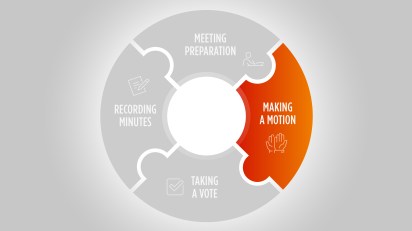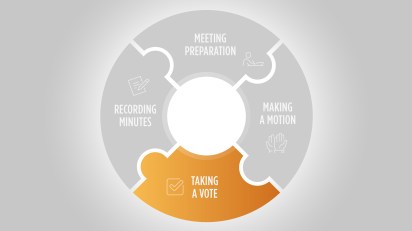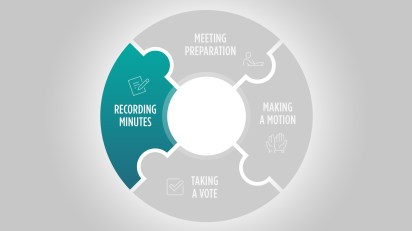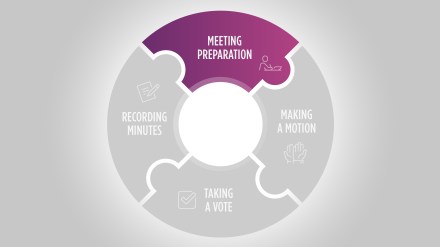Editor’s Note: Prepping for a church meeting is as important as the meeting itself. Continuing her look at effective business meetings through the hypothetical lens of Liz Jones, an experienced business administrator at First Church, Sarah E. Merkle walks us through the three-step process of planning, defining, and ordering a meeting agenda.
This four-part series is offered in support of Merkle’s “Mastering Meeting Basics.”
An effective church meeting can go a long way toward healthy and effective decision-making. Planning the meeting, therefore, is key.
Planning a church meeting: The problem
Liz Jones needs an effective business meeting plan.
Last year, First Church’s annual business meeting didn’t go so well. This year, Pastor Steve Hayes has asked Jones to fix that.
Jones, an experienced business administrator, knows preparation will be key. The congregationally led church is 16 years old and recently surpassed 500 members.
As the church grows, the need for meetings to go well only grows, too.
A few things went wrong at last year’s annual meeting:
- It ran too long.
- Discussion over pricey upgrades to the church’s audio/visual equipment went in circles.
- A key decision related to making a minor tweak to one of the church’s bylaws got delayed because proper notice wasn’t given ahead of time to members.
The next annual business meeting—planned for Sunday, January 8, 2023, at 12:30 p.m.— is still several months away, but Jones knows she needs to work fast to plan and organize it well.
A general search online yielded some ideas. Then she came across a Church Law & Tax article series by Sarah E. Merkle, an attorney with impressive credentials and experience helping churches, nonprofits, businesses, and organizations run meetings.
The article covering meeting preparation especially caught her eye. On a whim, she sent Merkle an email explaining her circumstances. A short while later, Merkle emailed back.
Creating an effective church meeting plan
Merkle couldn’t provide specific advice to Jones because legal ethics don’t allow it when an attorney-client relationship doesn’t exist.
But Merkle generally described steps Jones can take to put a better plan together.
Step 1: Get your to-do list in order
Put the church’s articles of incorporation, bylaws, and policy manuals all within arm’s reach, and read through them to note any dates by which things must happen. Whether nominating new board members or approving an annual budget or adopting a pastor’s housing allowance, these dates create deadlines—and to-do lists that should get completed by the appropriate meeting before the corresponding deadline.
For the annual business meeting, recurring dates include submitting board nominations whenever one or more members finish their terms, and getting congregational approval for the next year’s fiscal budget. This year, only the latter needs to happen.
Step 2: Define the agenda.
Merkle explained that initial formalities need to be addressed, such as approving the minutes of the last business meeting, plus adopting the agenda for this one.
From there, First Church needs its next fiscal budget approved. It also typically uses the annual business meeting to share updates from the church’s ministries, facilities, and financial health committees. This year, it also faces several other important decisions—it’s about to call a new associate pastor. It is also contemplating repaving its parking lot.
In the past, First Church has typically saved the biggest—and often most controversial—decisions for the end of its annual business meetings.
That’s what happened last year when the church wrestled with the audio/visual proposal. It was costly, members wanted to debate it, and, given that the meeting was already running long, frustrations mounted as a vote was pushed through.
Merkle cautioned Jones about prioritizing the agenda a certain way only because it’s “how the church has always done it.”
With the list of agenda items defined, Merkle said she asks these questions to further understand the potential flow for the agenda:
- Who should speak or present on behalf of any of the agenda items? The chair of the associate pastor search committee, for instance, should plan to talk about the candidate and explain the process used for the search, including the qualifications sought and the other people interviewed.
All presenters should be identified and contacted early to get them started with their respective presentations.
- What resources do these individuals need to succeed with their remarks? This might include PowerPoint and other audio/visual support—and it may require staff time to assist the presenter, especially if he or she is a volunteer.
- What information about an issue can be given to members ahead of time to help them learn and understand what the issue is about? For the associate pastor role, that might include a biography of the candidate. For the parking lot project, it might include an explanation about why it’s needed, the potential costs, and the ministry impact it can deliver.
- What notice is required under the church’s governance to ensure an issue can be voted on? Last year’s bylaw change didn’t provide proper notice—and this year, the church’s governance requires notice before members can vote to call any pastor.
Step 3: Ordering the agenda
The last major step is to order the agenda.
“There’s no right or wrong answer here,” Merkle wrote. “It’s more important to ask certain questions to decide how to do it. What are you ultimately wanting to accomplish at this meeting? Prioritize the agenda based on what needs to be decided for the healthy functioning of the church over the next 30 to 45 days.”
One evaluation is to anticipate controversies.
“Is everyone coming to the meeting because they are already angry about the issue? If so, then it needs to be earlier in the agenda,” Merkle wrote. “Is everyone coming calm, but an issue on the agenda may anger them? If so, then don’t schedule anything afterward that is heavy or serious—keep it straightforward.”
Another evaluation is the pros and cons of each item happening at specific times on the agenda.
With the associate pastor role, there are positives to placing it early on the agenda. Most people likely will attend because of this specific decision, and they’ll have more energy early in the meeting. One negative, though, is that updates about ministry and financial health may shape how people decide—and those reports would likely come later.
Relatedly, there are pros and cons to placing the item later in the agenda, too. The pro is that all information should be in hand. The con is that people are tired.
For Jones, the order is starting to take shape. Leading the agenda with the ministries, financial health, and facilities reports should start things on a positive note. The facilities report will then include the parking lot project.
From there, the agenda will shift into the associate pastor discussion and decision, since the meeting is still relatively young and the new role’s impact on the church’s mission and operations will be better understood.
Plus, adding the position directly influences the church’s healthy functioning within the next 45 days.
Lastly, the agenda will address approval of the next annual budget.
Jones now can begin working on contacting the individuals she needs to speak on the various topics, and the timetables needed to notify the congregation about the associate pastor vote.
“I’m really glad you reached out,” Merkle wrote. “The thought put into an annual business meeting can turn it into something invigorating. The time you’re using now to prepare can make a massive difference in how people feel—helping them see the big picture and celebrate the church’s direction.”

Part 2 of 4: Managing Meeting Motions

Part 3 of 4: Making Every Vote Count

